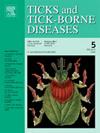美国钝足螨(蜱螨亚纲:蜱螨科)俄克拉荷马立克次体的分离、培养和基因组分析
IF 3.4
2区 医学
Q2 INFECTIOUS DISEASES
引用次数: 0
摘要
以前在俄克拉荷马州(据报道立克次体血清阳性率高的州)通过分子检测发现了一种未表征的立克次体。美洲钝眼蜱是具有攻击性的捕食者,能够传播导致人类和动物疾病的病毒、原生动物和细菌物种。发现和鉴定这种蜱类的新微生物对鉴定潜在的新病原体至关重要。利用从俄克拉荷马州收集的美洲蜱虫,我们分离、培养并测序了一种以前检测到的、但未表征的新型立克次体物种的整个基因组。以美洲蜱为接种物,在Vero E6细胞中培养新型立克次体,qPCR检测证实了新立克次体的存在,同时排除了其他蜱媒生物的存在。总基因组大小为1.17 Mbp,包括一条完整的染色体,G+C含量为30.7% (GenBank登录CP157197)。我们预测了1037个基因,997个编码基因开放阅读框,以及33个trna, 4个ncrna和3个rnas。根据平均核苷酸同源性分析,该基因组与加拿大立克次体菌株CA410最相似,同源性为91.1%。使用636个连接的核心蛋白构建的最大似然系统发育树将新型立克次体与加拿大立克次体置于一个分支中。我们建议命名为俄克拉何马立克次体sp. nov.,菌株俄克拉何马10,该菌株可从美国乔治亚州亚特兰大疾病控制和预防中心立克次体分离参考库(WDCM 1093)获得(CRIRC登录号ROK001)。本文章由计算机程序翻译,如有差异,请以英文原文为准。
Isolation, culture, and genome analysis of Rickettsia oklahomensis sp. nov. (Rickettsiales: Rickettsiaceae) from Amblyomma americanum (Acari: Ixodidae)
An uncharacterized Rickettsia species was previously identified by molecular detection in Amblyomma americanum ticks from Oklahoma, a state reported to have high Rickettsia seroprevalence. Amblyomma americanum ticks are aggressive feeders capable of transmitting viral, protozoal and bacterial species that cause diseases in humans and animals. Discovering and characterizing novel microorganisms in this tick species is crucial for identifying potential new pathogens. Using A. americanum ticks collected from Oklahoma, we isolated, cultured and sequenced the entire genome of a previously detected, but uncharacterized, novel Rickettsia species. Triturated A. americanum ticks were used as inoculum to culture the novel Rickettsia species in Vero E6 cells, and qPCR testing confirmed the presence of the new Rickettsia species while ruling out the presence of other tick-borne organisms. The total genome size was 1.17 Mbp consisting of a complete chromosome with a 30.7 % G+C content (GenBank accession CP157197). We predicted 1037 genes, 997 coding gene open reading frames, along with 33 tRNAs, 4 ncRNAs and 3 rRNAs. This genome was most similar to Rickettsia canadensis strain CA410 at 91.1 % identity, based on average nucleotide identity analysis. A maximum-likelihood phylogeny tree, constructed using 636 concatenated core proteins, placed the novel Rickettsia species in a clade with Rickettsia canadensis. We propose the name Rickettsia oklahomensis sp. nov., strain Oklahoma 10, which is available from the Centers for Disease Control and Prevention Rickettsial Isolate Reference Collection (WDCM 1093), Atlanta, GA, USA (CRIRC accession number ROK001).
求助全文
通过发布文献求助,成功后即可免费获取论文全文。
去求助
来源期刊

Ticks and Tick-borne Diseases
INFECTIOUS DISEASES-MICROBIOLOGY
CiteScore
6.90
自引率
12.50%
发文量
185
审稿时长
6-12 weeks
期刊介绍:
Ticks and Tick-borne Diseases is an international, peer-reviewed scientific journal. It publishes original research papers, short communications, state-of-the-art mini-reviews, letters to the editor, clinical-case studies, announcements of pertinent international meetings, and editorials.
The journal covers a broad spectrum and brings together various disciplines, for example, zoology, microbiology, molecular biology, genetics, mathematical modelling, veterinary and human medicine. Multidisciplinary approaches and the use of conventional and novel methods/methodologies (in the field and in the laboratory) are crucial for deeper understanding of the natural processes and human behaviour/activities that result in human or animal diseases and in economic effects of ticks and tick-borne pathogens. Such understanding is essential for management of tick populations and tick-borne diseases in an effective and environmentally acceptable manner.
 求助内容:
求助内容: 应助结果提醒方式:
应助结果提醒方式:


